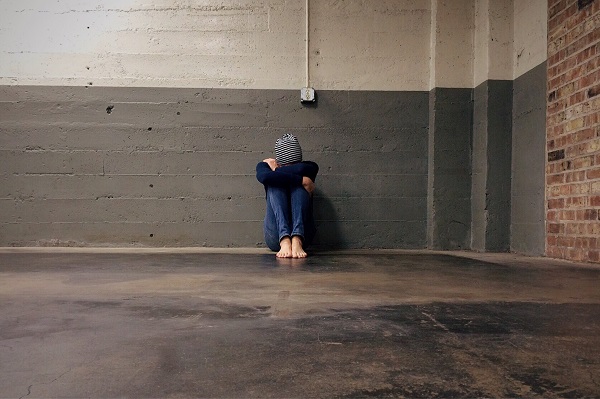Part I: From Onset to Diagnosis
For Fibromyalgia Awareness Month, I wanted to share my illness journey here on the blog. My story starts eight years ago. It wasn’t a climactic beginning. It was just achy low back pain that got worse the longer I sat writing my M.A. thesis. It seemed like a common enough problem to have, except for the fact that I was 23. The nurse told me to take ibuprofen 24/7 and stretch. Spoiler alert: it didn’t work. About a year later, my body gradually began to fall apart, limb by limb. My back pain worsened. My knee gave out. My shoulders become too painful to allow me to type. This is what the doctors call “gradual onset”.
I thought I was losing my mind.
My doctor at the time told me all she could do was suggest Robaxacet. At this point, I was starting my Ph.D. The physical demands of reading and writing 24/7 began to take their toll, exacerbating my pain. Daily functioning on my own became increasingly difficult. My fiancé (now husband), who was living 4 hours away, had to come every weekend to help me with the chores (groceries, cleaning, etc.) that I could no longer do. In retrospect, I think the stress of the program and my fear about not being able to meet expectations, as well as not being able to understand what was happening to me, pushed my body past the point of no return. After that, I developed more of the classic fibromyalgia symptoms, like insomnia, fatigue, and digestive problems.
I was fortunate to have been referred previously to a pain clinic for pelvic pain. This meant I was able to see a pain specialist for my musculoskeletal pain within the same year all my fibro symptoms exploded. In March 2012 he diagnosed me with fibromyalgia.
Click Here to Visit the Store and find Much More….
Part II: Change, Anxiety and Trying to Cope
I was so relieved after my diagnosis that my symptoms had been validated – and given better medication than NSAIDs. I was given tramadol, which reduced my pain, and doxepin, which helped me to sleep. But I still hadn’t absorbed yet what this diagnosis would mean for my future. After my diagnosis, it became obvious that even with treatment, no amount of accommodations would allow me to continue my Ph.D. I had tried everything I could think of so I could stay – withdrawn from my TA position, put in place disability accommodations to allow me to submit work late, bought expensive adaptive devices, and installed voice recognition software.
Feeling like my life was spinning out of control, I started having panic attacks on campus. When the spring term ended, I went back home to move in with my fiancé and decided to withdraw from the Ph.D. program.
With huge relief, I went on medical leave from my studies. However, I was immediately confronted by the problem that my days were empty of activity or responsibility. I remember dragging myself out to a local cafe in the afternoons while my fiancé was at work. I wanted the anonymity of a public place, where I could feel ‘normal’ for a while. It was the only cafe I could go to because the chairs were sensible rather than funky. Still, I had to bring my backrest with me, which generated stares from other patrons. I would cover it with my coat in order to try to hide it from attention. I could no longer type or hold a book due to pain, so I was embarrassed to be sitting at a table without a laptop or reading material, like everyone else. I listened to audiobooks or free online course video lectures instead. I would set up my tablet so that it looked like I was working, rather than listening and staring around. I envied all the other people my age, surrounded by papers, purposely tapping away on their computers. The goals that I had been pursuing were on pause, indefinitely. I grieved for my old life. I pushed myself to go to the cafe, even on days I experience brain fog or fatigue because staying home felt like giving up. I spent that year in a state of shock. I was always someone whose identity was wrapped up in my work. I didn’t know who I was anymore.
Part III: Learning Self-Care Skills to Manage my Fibro
Gradually I started trying to put the pieces back together. When I got diagnosed with my chronic condition all the information about exercise seemed so out of touch with the reality of my life. At the time, I had trouble bending forward, which meant I needed help with basic tasks like shaving my legs. I had trouble getting up or down from sitting on the floor. I rarely took the stairs and had trouble walking or standing for longer than ten minutes. Since I was already tired, sore, and busy then I wasn’t going to be able to go to the gym. I couldn’t afford a personal trainer. With my back pain, there was no way I could participate in the group yoga classes I used to take in university. Even more frustrating was the fact that all the research I came across proved how beneficial exercise is to health. I knew that I should exercise but I felt like I couldn’t.
I found two at-home instructional DVDs in yoga/pilates and tai chi that I was actually able to do, which helped me to improve my physical functioning. I started seeing a physiotherapist who put together a thorough stretching routine for me to do daily. Without a doubt, this is the single most effective thing I tried to improve my health and well-being. My pain decreased and my quality of life increased.
I was fortunate to be referred to a Cognitive Behavioural Therapy program by my pain clinic. I found participating in the course very valuable for learning tools to manage the negative thoughts and feelings that accompanied my fibromyalgia. One of the core parts of the program was learning to identify negative thinking traps or ‘cognitive distortions. These are thoughts that “sound rational and accurate, but really only serve to keep us feeling bad about ourselves.” I learned that I tend to think in “all or nothing” terms – a cognitive distortion. I would say to myself things like “if I can no longer pursue my career, I am a failure in life”. In CBT, I learned to challenge these distortions with the reality of each situation. For example, in response to the statement above, I challenged it by saying “While being in pain means I have to do less, that does not reflect on my personal worth, nor does it mean what I can do is meaningless”.
I was also referred for a Mindfulness–Based Stress Reduction course by the pain clinic. In this course, I learned to be more mindful of the present moment. I learned that worrying about the future or dwelling on the past, only makes me suffer more in the present. It’s better for my quality of life if I return my focus to the next best thing I can do for myself at this moment. Critically, the MBSR course reminded me that, even with pain and flare–ups, there are small moments of enjoyment, if I only stop and notice them – the taste of a good meal, sharing a hug, a sunny day, or a favorite hobby. One of the key lessons I learned through mindfulness is that my thoughts, feelings, and sensations, no matter how difficult, are changeable, like the weather. When I hold on to the fact that even my darkest moods will eventually lift, I feel calmer and more in control.
Click Here to Visit the Store and find Much More….
Part IV: Coping with Relapse
In 2014 I started a part-time distance program for social work and completed the first year. But it wasn’t to be. I got a cold over the 2015 holidays and suffered the worst fatigue and brain fog I’d ever known. At the time I was just starting to look for a social work practicum placement. There was no way I could commit to working 15 hours a week out of my home. For the second time, I had to withdraw from school.
I felt completely overwhelmed at the outset of my fatigue relapse last year. First, there was the emotional reaction to a new situation: anxiety about whether it was here to stay, frustration that life was about to get more difficult, and grief at the prospect of losing what abilities I still had. Secondly, there was the practical challenge of figuring out how I would cope, like what new treatment options to try or how to manage my daily routines and responsibilities. Lastly, I faced the impact of a relapse on my relationships, such as the increased caregiver burden on my partner, and feeling less able to be present with family and friends.
My relapse brought me back to the beginning of my illness journey and how I coped after my diagnosis. I was able to use many of the lessons that had been learned the hard way the first time around. In essence, what I have learned is that I have the power of choice over what I focus my attention on each day. Through challenging negative patterns of thinking, being present, taking in the good, and pursuing an enjoyable hobby, I try to emphasize what enriches my life and let go of what doesn’t. Of course, there are always bad days and I don’t believe any amount of positive thinking frees us from ever experiencing difficult times. I personally have found, however, that changing my worldview has dramatically lessened the amount of suffering I go through during relapses and has improved my quality of life. I spent that winter using the time to learn new things. I taught myself calligraphy, I read, and I wrote more often on my blog.
Part V: Moving Forward, Maintaining Balance
That spring, my energy began to slowly improve. I found a kind of peace in accepting that whatever I do next, needs to allow me to work with my body and not against it. I think that’s why blogging and writing have ‘clicked’ more for me now than when I first started. I have found that grieving for your old life and finding acceptance in your new life is an ongoing process, not a one-and-done kind of thing.
Being at home allows me to respond to each day as it is. I’m fortunate to be able to stay at home. I sleep in late because without ten hours I am a brain-fogged zombie. I can’t type because of shoulder pain but I can use speech recognition software. I stretch, do gentle exercise, walk, and make sure I move around during the day. I balance my activities with self-care, which is how I am able to live more fully, even with fibromyalgia.
In the summer of 2015 I felt well enough to finally plan my (fibro-friendly) wedding. On a beautiful August day, I married the man I’d fallen madly in love with eight years earlier and who has been my saving grace through this whole journey. He didn’t blink when it came to assuming caregiving responsibilities – he does the housework, the laundry, and the dishes on top of his full-time job. He is always understanding when we have to change plans or just stay at home. Most of all he is so supportive. He celebrates the small accomplishments of my life without ever making me feel ‘less than.
I’m grateful for how I’ve grown through encountering all of the challenges that come with chronic illness. Learning mindfulness meditation and focusing on the present has given me a more helpful perspective. I’m a happier person when I remember to ‘stop and smell the roses. I feel like I’ve become more patient, more adaptable, more assertive, and more accepting than I was before fibromyalgia. I’m proud of making it through every day, especially on the tough days where no amount of self-care stops your symptoms, and you just have to hold on to the knowledge that it will pass. Everyone living with chronic illness should be proud of the strength they have developed to manage daily life.
My new motto is something I read shortly after my diagnosis – “It’s not the life you imagined, but it’s a good life nonetheless.” It’s something I hope for myself and everyone who lives with fibromyalgia.

Click Here to Visit the Store and find Much More….
For More Information Related to Fibromyalgia Visit below sites:
References:
Fibromyalgia Contact Us Directly
Click here to Contact us Directly on Inbox
Official Fibromyalgia Blogs
Click here to Get the latest Chronic illness Updates
Fibromyalgia Stores







